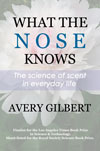We’ve been hearing a lot about dog noses recently and how they are far more sensitive than ours. Liz Bestic kicked things off with a July 1 story in New Scientist called “The cancer sniffers: Dogs could be the best tool for diagnosis.” She covers some studies showing that dogs are able to sniff out specimens from patients with various types of cancer. An infographic accompanying her story states
“A dog’s sense of smell is between 1000 and 100,000 times more sensitive than that of humans.”Next up was Rachel Pannett, the Sydney-based Deputy Bureau Chief for The Wall Street Journal in Australia and New Zealand. Her story appeared on the front page of the July 16, 2015 edition: “Forget drugs, these dogs sniff out a different kind of evil weed: Australia tries using spaniels to hunt for invasive plants called orange hawkweed, a.k.a ‘Grim the Collier’.” Pannett’s story includes this line:
A dog’s nose can be over 10,000 times more sensitive than humans, according to academic studies.Zounds! Those are some impressive numbers. No wonder those dogs can sniff out cancer—their sense of smell is soooo much more sensitive than ours.
But wait. What’s that beeping sound in the distance? Why, it’s the alarm on the FirstNerve Bogosity Meter (hooked up to the battery of a rusty Ford F150 behind the tool shed). It seems there might be something dodgy about these doggy claims.
First off, let’s assume for the sake of argument that all the experimental results are correct and dogs can reliably sniff out a variety of human cancers. What does that prove about the relative sensitivity of dog noses and human noses? The answer is: nothing at all. Relative sensitivity is logically irrelevant to these results. But for some reason, journalists feel compelled to assert that dogs have more sensitive noses than we do. A competitive sniff-off between dogs and humans would address the point directly. It would be nice if a Deputy Bureau Chief or a “health journalist” asked cancer study researchers whether they had, you know, let human panelists evaluate the scent samples the same way the dogs did. Wouldn’t it be interesting if a bunch of orderlies, interns, and maintenance people could sniff out cancer? (Bestic mentions that doctors since Hippocrates have used smell as a diagnostic tool. She doesn’t explain why 21st century physicians have suddenly ceded the game to dogs.)
Hey! Will someone please turn down the alarm on the Bogosity Meter? It’s getting on my nerves.
The next fishy thing about these stories is the beautiful, quote-tastic simplicity of the numbers: dogs are 1,000 or 10,000 or 100,000 thousand times more sensitive than humans. Not 27,000 times more sensitive. Not 1,450 times. But more sensitive by nice fat powers of ten.
Bestic and Pannett are merely the latest journalists to run with these numbers. Here is Mary Bates, PhD, writing on the Animal Minds blog at PsychologyToday.com in 2012 (“Cancer-detecting canines sniff out a diagnosis”):
Canines’ sense of smell is generally 10,000 -100,000 times superior to that of humans.Stefan Lovgren (“Dogs smell cancer in patients’ breath, study shows,” National Geographic News, 2006) and Peter Tyson (“Dogs’ dazzling sense of smell,” scienceNOW blog at PBS.org, 2012) use the same comparisons.
So where are journalists getting these numbers? Unlike their colleagues, Lovgren and Tyson attribute them to a specific person. Here’s Lovgren:
According to James Walker, director of the Sensory Research Institute at Florida State University in Tallahassee, canines’ sense of smell is generally 10,000 to 100,000 times superior to that of humans.And here’s Tyson:
Dogs’ sense of smell overpowers our own by orders of magnitude—it’s 10,000 to 100,000 times as acute, scientists say. “Let’s suppose they’re just 10,000 times better,” says James Walker, former director of the Sensory Research Institute at Florida State University, who, with several colleagues, came up with that jaw-dropping estimate during a rigorously designed, oft-cited study.”Now we’re getting somewhere—the 10,000 to 100,000 claim was made by a smell scientist. [Full disclosure: I met Jim Walker numerous times at the AChemS meetings long ago.] Walker and his colleagues were once active in designing new ways to measure olfactory sensitivity. In 2003, they published a paper in Chemical Senses called “Human odor detectability: new methodology used to determine threshold and variation.” Using their new technique, they estimated a value for human sensitivity to amyl acetate, a chemical that smells like bananas and is something of a standard odor in studies on olfactory thresholds. So far, so good.
In 2006, Walker and colleagues published “Naturalistic quantification of canine olfactory sensitivity” in Applied Animal Behaviour Science. They tested two dogs (a Rottweiler and Standard Schnauzer) for sensitivity to amyl acetate. The threshold value they found was lower than that reported previously by other dog researchers, presumably reflecting the more precise experimental methods used.
In discussing the results, the researchers wrote
Our recent investigation of human odor detectability (Walker et al., 2003) yielded thresholds approximately 10,000- to 100,000-fold higher than those we report here for the dog.Again, so far, so good. But note: the “10,000- to 100,000-fold higher” statement applies only to amyl acetate (i.e., one specific chemical) and only to two studies (i.e., those coauthored by Walker). Yet Lovgren and Tyson quote Walker with the clear implication that dogs are 10,000 to 100,000 time more sensitive to smells in general. Either Walker did not mention these limitations when he was interviewed by them, or he mentioned the caveat and they chose to ignore it. In any case, journalists are now on notice that they should be cautious in how they quote Walker and/or his 10K/100K claims of canine smell superiority.
Still, there exists a strong presumption that dogs have a sense of smell that is more sensitive than ours in general, i.e., for the vast majority of odors. Surely there are other studies on other odor chemicals that support the claim, no? Enter Matthias Laska, a professor at Linköping University in Sweden. Laska is far and away the current authority of olfactory sensitivity in mammals—he has conducted smell experiments with mice, spider monkeys, squirrel monkeys, pigtail macaques, elephants, and fur seals. At this year’s AChemS meeting in April, Laska gave a talk titled “Busting a myth: humans are not generally less sensitive to odors than nonhuman mammals.” (Abstract here.) I attended his presentation and found it compelling.
Laska put together a data base of all published odor thresholds for humans and nonhuman mammals (17 species tested across a total of 138 odors). This let him compare the relative performance of humans and other species on a chemical-by-chemical basis.
I found that human subjects have lower olfactory detection thresholds, that is, a higher sensitivity with the majority of odorants tested so far compared to most of the nonhuman mammal species tested so far. This includes species traditionally considered to have a highly developed sense of smell such as mice, hedgehogs, shrews, pigs and rabbits. Humans outperform rats with 31 of the 41 odorants tested with both species. Humans even outperform the dog, often considered as the undisputed super-nose of the animal kingdom, with 5 of the 15 odorants tested with both species. Based on these comparisons, and contrary to traditional textbook wisdom, humans are not generally inferior in their olfactory sensitivity compared to nonhuman mammals.So according to the most recent, most comprehensive review of the topic, humans outperform dogs on 5 of the 15 odorants tested. Does that sound like total, across-the-board, doggy nose superiority to you? No, not really.
After the recent flurry of dog superiority claims, I checked in with Laska by email. He confirms that the canine odor threshold for amyl acetate (-5.94 log ppm) reported in Walker’s 2006 study is the lowest on record. However, he points out that the lowest reported human threshold for amyl acetate in his database is -7.02 log ppm. In other words, when it comes to amyl acetate humans are more sensitive than dogs.
Let me repeat that: According to all the available scientific evidence, humans are more sensitive to amyl acetate than are dogs.
Where does this leave us? With three take-home messages:
#1: James Walker’s narrow claim that dogs are 10,000 to 100,000 times more sensitive to amyl acetate than humans is simply incorrect. The fact is that humans, not dogs, are more sensitive to amyl acetate.
#2: The broader, and much-cited claim that dogs are 10,000 to 100,000 times more sensitive to smells in general is unsubstantiated. The fact is that dogs outperform humans on some but not all of the smells tested to date.
#3: The media ought to take a healthily skeptical approach to claims about the incredible superiority of the canine sense of smell. Some of us have expressed reservations about this before, and have noted that undue deference to the dog nose leads to some dubious outcomes in the criminal justice system. Even assuming that all the studies to date are valid and replicable, the practicality and cost-benefit ratio of cancer detection with sniffer dogs is not that impressive.
P.S. Don’t even bother coming back at me with the claim by one Dr. Lawrence Myers. “Dr. Myers has been quoted as saying dogs can smell a million times better than humans. He says that was a speculative (but possible) number he used in an interview to illustrate a narrow point. The reporter picked up the figure as science and quoted it out of proper context.”
P.P.S. Und danke schön, German dog fans, but don’t bother digging up this old bone from 1953: “The olfactory sensitivity of the dog is 1,000,000 to 100,000,000 times better than humans.” [My translation.] It’s a hand-waving, one-line summary of results, now superseded, that dates back to the dawn of olfactory psychophysics.
The studies discussed here are “Human odor detectability: new methodology used to determine threshold and variation,” by James C. Walker, Sandra B. Hall, Dianne B. Walker, Martin S. Kendal-Reed, Alison F. Hood & Xu-Feng Niu. Chemical Senses 28, 817–826, 2003; “Naturalistic quantification of canine olfactory sensitivity,” by Dianne Beidler Walker, James Cornelius Walker, Peter James Cavnar, Jennifer Leigh Taylor, Duane Howard Pickel, Sandra Biddle Hall & Joseph Carlos Suarez. Applied Animal Behaviour Science 97, 241–254, 2006; and “Über die Riechschärfe des Hundes für Fettsäuren,” by Walter Neuhaus. Zeitschrift für vergleichende Physiologie 35, 527-552, 1953.





3 comments:
Thank you for setting the record straight, Avery. This is the last time I'll ever ask Rodrigo the Perfume Dog to confirm that the milk is sour. (The fact that he'll eat day-old chicken out of the garbage should've tipped me off.)
Katie Puckrik:
Give Rodrigo his due--if your ever need to know who in the neighborhood is in heat, his is the nose to trust. On leftovers, maybe not so much . . .
https://medicalxpress.com/news/2017-03-dogs-breast-cancer-bandage.html
Post a Comment